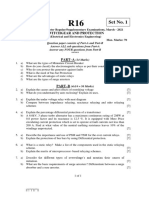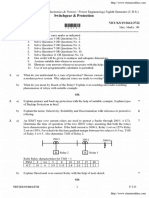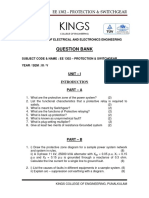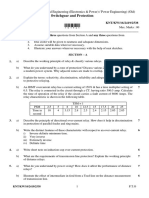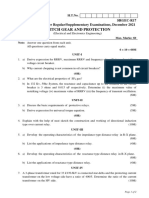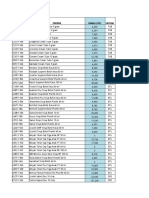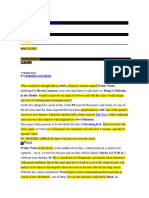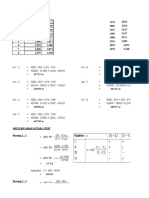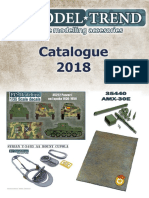Unit 1
1. Define and explain the following terms briefly with waveform
(i) Arc voltage (ii) Restriking voltage (iii) Recovery voltage.
2. What is fuse? What are the desirable characteristics of the fuse? Give the
relation between fusing current and diameter of fuse.
3. Describe the construction, principle of operation and application of SF6 circuit
breaker.
4. Derive an expression for the restriking voltage in terms of system voltage,
inductance and capacitance, across a C.B. contact when a 3-phase fault takes
place.
5. Briefly explain the methods of arc extinction in circuit breakers.
6. Describe the construction, principle of operation and application of air blast
circuit breaker.
7. In a short circuit test on a 3-pole, 132 kV C.B. the following observations
are made: p.f. of fault 0.3, the recovery voltage 0.85 times full line value, the
breaking current symmetrical, the frequency of oscillations of restriking voltage
18 kHz. Assume that the neutral is grounded and the fault does not involve
ground; determine the average rate of rise of restriking voltage.
8. In a system of 220 kV, the line to ground capacitance is 0.001 µF and the
inductance is 5 henries. Determine the voltage appearing across the pole of a
C.B. if a magnetising current of 7 amps (rms value) is interrupted. Determine
also the value of resistance to be used across the contacts to eliminate the
restriking voltage.
9. A circuit breaker is rated 1500A, 1500 MVA, 33 kV, 3-sec, 3-phase oil circuit
breaker. Determine the (i) normal rated current (ii) breaking current (iii) making
current (iv) short time rating.
10.Describe the construction, operating principle and application of vacuum circuit
breaker.
11.Determine the RRRV for the circuit breaker installed on a 400 kV, 3 phase, 50Hz
system. Following data were recorded, when a short circuit grounded fault
occurred. Given: Recovery voltage =0.97 of full line value, power factor of a
fault =0.45. Natural frequency for symmetrical breaking current =16 kHz
12.Explain why current chopping is not a problem with Vacuum circuit breaker.
Unit 2
1. What is a protective relay? Explain the functional characteristics of a protective
relay.
2. Explain with neat diagram the construction and working of induction type
directional power relay.
3. Write a short note on current, voltage balance and percentage differential
protection scheme with neat diagram.
4. Derive the torque equation of induction type relay.
5. What is Universal Torque Equation? Using this equation derive the following
relay’s characteristics:
(i) impedance relay (ii) reactance relay (iii) mho relay.
6. Explain with neat diagram and operating characteristics of Mho Relays.
7. An IDMT type over current relay is used to protect a feeder through CT having
ratio 500/1. The relay has plug setting of 150% and TMS=0.3. Find the time of
operation of the said relay if fault current of 4000 A flows through the feeder.
PSM 3 8 15
Time for
6 3.2 2.5
unity TMS
� 8. The distribution system shown in figure is to be protected by over current
system of protection. For proper fault discrimination directional over current
relays will be required at what locations and give reasons.
9. Consider a stator winding of an alternator with an internal high resistance
ground fault. The currents under the fault condition are as shown in the figure.
The winding is protected using a differential current scheme with current
transformers of ratio 400/5 A as shown. The current through the operating coil
is.
10.For the protection of transmission line section a reactance relay is used by
setting Impedance Z=4+j3. An L-G fault developed with arc resistance of 3 Ω in
the protected section and fault impedance up to fault point is (2+j2) Ω. Check
whether the relay is operated or not and justify your answer.
11.What is meant by percent bias? How is this achieved in practice in differential
relay? Under what circumstances is a percentage differential relay preferred
over the differential relay?
12.Calculate the PSM suitable for a relay setting of 150%, if the fault current is
1500 A. The CT ratio is 150/5. Also determine the time of operation of the relay
corresponding to the PSM. Find the time setting dial is set at 0.2 and the time of
operation of the relay when set at 1.0 is 1.56.
13.Determine the PSM for rating 5 A, 2.2 sec IDMT and having a replay setting of
125% TMS=.6. It is connected to a supply circuit through a C.T 400/5 ratio. If
the fault current is 3600 amps.
Unit 3
1. Describe briefly various abnormal conditions developed in alternator.
2. Explain with neat diagram the application of Merz-Price circulating current
principle for the protection of alternator.
3. Draw the circuit diagram to detect inter turn fault in an alternator
4. Draw the circuit diagram and explain Balanced Earth-Fault in an alternator.
5. Can a generator allowed to run with prime mover lost? If not, why?
6. A star connected 3-phase, 10 MVA 6.6 kV alternators is protected by Merz price
circulating current principle using 1000/5 A CT. The star point of alternator is
earthed through a resistance of 6.5Ω. If the minimum operating current for the
relay is 0.75 A, calculate the percentage of each phase of the stator winding
which is unprotected against earth faults when the machine is operating at
normal voltage.
7. Why it is necessary to suppress the field immediately after the disconnection of
faulty alternator from the system. Justify your answer.
8. Why large alternators neutral is grounded with large resistance. Justify you
answer.
9. An 11kV, 100MVA generator is grounded through a resistance of 6 ohms CT
have a ratio of 1000/5. The relay is to set operate when there is out of balance
current of 1A what is percentage of generator winding will be protected by the
percentage differential scheme of protection.








